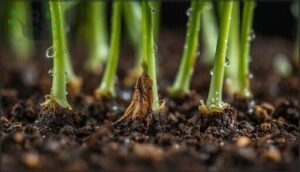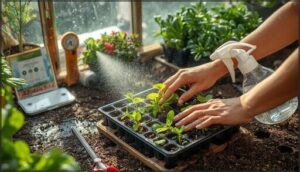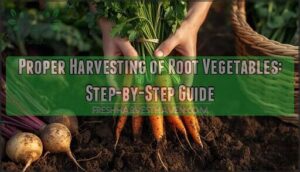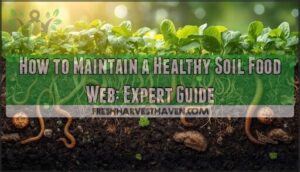This site is supported by our readers. We may earn a commission, at no cost to you, if you purchase through links.
You can lose an entire flat of seedlings overnight to damping off disease. One day your tomato starts look healthy, the next morning they’ve collapsed at the soil line like tiny felled trees. This fungal disease doesn’t give second chances, and it strikes when conditions turn cool and wet.
The fungi responsible—Pythium, Rhizoctonia, and Fusarium—live in soil, water, and on contaminated tools, waiting for the right moment to attack vulnerable seedlings. Prevention is your only real defense because once damping off takes hold, infected seedlings can’t be saved.
The good news? You can prevent damping off disease in seedlings by controlling the environment and eliminating the fungi before they strike.
Table Of Contents
- Key Takeaways
- What is Damping Off Disease?
- Causes of Damping Off in Seedlings
- How to Recognize Damping Off Symptoms
- Step-by-Step Prevention Methods
- Managing and Treating Damping Off
- Frequently Asked Questions (FAQs)
- Can damping off spread to nearby mature plants?
- Which fungicides work best for seedling protection?
- How long does soil remain infectious after outbreak?
- Are organic growing methods more susceptible to damping off?
- Can bottom watering reduce damping off risk effectively?
- Can damping off affect transplanted seedlings outdoors?
- How long do damping off pathogens survive?
- Are organic seeds more susceptible to damping?
- Does bottom watering reduce damping off risk?
- Can beneficial microbes prevent damping off disease?
- Conclusion
Key Takeaways
- Damping off is a fatal fungal disease caused by Pythium, Rhizoctonia, and Fusarium that kills seedlings at the soil line within days, often wiping out 80-100% of trays in cool, wet conditions where prevention is your only defense since infected plants can’t be saved.
- You prevent damping off by sterilizing all pots and tools in 10% bleach solution, using fresh sterile seed-starting mix with good drainage, watering only when the top inch is dry, and running a fan to keep air moving around seedlings.
- Soil temperature matters more than most gardeners realize—warming your mix to 70-75°F with a heating pad speeds germination faster than fungi can strike, while saturated soil shows 80% infection rates compared to under 10% in well-drained media.
- If damping off appears, remove infected seedlings immediately with surrounding soil, cut back on watering, increase airflow, and consider biological controls like Trichoderma or compost tea since the pathogens survive in soil for years waiting for the next vulnerable crop.
What is Damping Off Disease?
Damping off is a fatal disease that strikes seedlings when they’re most vulnerable, often wiping out entire trays before your plants even get started. It’s caused by soil-borne fungi and molds that thrive in cool, wet conditions, attacking young plants at or below the soil line.
Understanding what this disease is and how it impacts your garden is the first step in protecting your seedlings from this common threat.
Definition and Overview
Damping off disease is a fungal disease that kills seedlings at or near the soil line, often before they even break through the soil. This seedling disease is caused by several pathogens, including Pythium, Rhizoctonia, and Fusarium.
Disease progression happens fast in cool, wet conditions. Seedling mortality can wipe out entire trays, making disease prevention essential to avoid economic losses. Proper prevention includes managing soil temperature to inhibit fungal growth.
Impact on Seedlings and Plant Loss
Once infection takes hold, plant loss can be staggering. In severe cases, stand reduction can wipe out 80–100% of your seedlings, leaving bare patches in trays or beds. Root system effects compound the problem—infected roots lose up to 41% of their weight, crippling nutrient uptake. Plant stunting follows, with survivors showing twisted stems and weak growth. These spatial patterns of collapse directly slash yield potential, sometimes cutting harvests by 30% in affected crops. Understanding Rhizoctonia’s impact on roots can help inform better soil management.
- Stand reduction: Up to 100% seedling mortality in severely affected patches
- Root system effects: Infected roots lose around 41% of their mass
- Plant stunting: Survivors develop constricted, wiry stems and weak foliage
- Yield potential: Losses can reach 30% in affected soybean and cereal fields
Common Susceptible Vegetables and Flowers
Those spatial patterns of collapse don’t affect all plants equally. Vegetable plants like tomatoes, peppers, cabbage, and lettuce face frequent attacks, while flower plants, including petunias, pansies, and snapdragons, struggle in humid flats. Host susceptibility varies by species and growing conditions, but preventing damping off starts with knowing which seedlings face the highest risk.
| Vegetable Category | Common Hosts | Typical Loss |
|---|---|---|
| Solanaceous Seedlings | Tomatoes, peppers, eggplant | Wire stem, root rot |
| Brassica Seedlings | Cabbage, cauliflower, kale | Up to 80–100% stand loss |
| Leafy Greens | Lettuce, spinach, beets | Significant tray failures |
| Flower Seedlings | Petunias, pansies, snapdragons | Bed rot, stem collapse |
Causes of Damping Off in Seedlings
Damping off doesn’t just appear out of nowhere. It’s triggered by specific fungi and environmental conditions that create the perfect storm for seedling disease.
Understanding what causes this problem is your first step toward stopping it before it starts.
Soil-Borne Fungi and Water Molds
Your seedlings face invisible enemies lurking beneath the surface. Damping off comes from soilborne pathogens like Pythium, Rhizoctonia, and Fusarium—fungi and water molds that wait in soil and plant debris for the right conditions to strike.
- Pythium species spread through contaminated water and can infect over 12% of seedlings pre-emergence
- Rhizoctonia solani reduces root volume by up to 96% in infected plants
- Fusarium produces enzymes that cause rapid seedling collapse near the soil line
- Phytophthora water molds thrive as generalist pathogens affecting multiple plant species
These organisms survive on dirty pots, tools, and workbenches indefinitely, making pathogen identification and soil contamination management essential for your success.
Environmental Factors (Moisture, Temperature)
When soil saturation combines with cool temperatures below 60°F or warm conditions above 75°F, damping off pathogens thrive. High humidity around your seedlings and poor air circulation create the perfect storm.
Soil moisture matters more than you’d think—trays watered to saturation show 80% infection rates versus under 10% in well-drained media. Environmental conditions make or break your seedlings’ survival.
Soil moisture is critical: saturated trays suffer 80% infection rates while well-drained media see under 10%
Contaminated Tools, Pots, and Potting Mix
Your old pots, trays, and tools become pathogen highways if you skip decontaminating gardening tools between crops. Damping off fungi survive for years in soil clinging to equipment, turning reused pot risks into guaranteed losses.
Even your potting mix can harbor these killers unless it’s pathogen-free through soil sterilization. Without a sterile environment and proper disinfectant efficacy against surface contact risks, you’re planting into a disease factory.
How to Recognize Damping Off Symptoms
Catching damping off early can save your entire tray of seedlings.
The disease shows up in different ways depending on when it strikes, and knowing what to look for helps you act fast.
Let’s walk through the telltale signs so you can spot trouble before it spreads.
Pre-Emergence Vs. Post-Emergence Signs
Distinguishing between preemergence and postemergence damping off helps pinpoint when the disease struck. Before emergence, seed rot or radicle infection stops germination entirely—you’ll notice empty spots where seeds never surfaced.
After emergence, hypocotyl lesions appear at the soil line, seedlings collapse, and sometimes you’ll see surface growth like white fuzz around infected stems, marking a clear diagnostic divide.
Stem and Root Changes in Seedlings
Once damping off takes hold, you’ll see telltale changes in seedling stems and roots. Hypocotyl constriction creates a pinched zone at the soil line where tissue narrows and turns translucent before collapse.
Root rot strips away fine feeder roots, leaving discolored, brown-to-black stumps. Vascular impairment disrupts water relations, triggering wilting even in moist soil—classic symptoms of damping off at work.
Distinguishing Damping Off From Other Diseases
Many foliar diseases and nutrient deficiency patterns show up gradually over weeks, but damping off kills seedlings within seven to fourteen days of germination. Root rot from other causes rarely produces the sharp stem constriction that defines identifying damping off symptoms during plant disease diagnosis.
You’ll spot abiotic stress or insect damage scattered across trays, while symptoms of damping off cluster in wet patches where thirty to one hundred percent of seedlings collapse.
Step-by-Step Prevention Methods
Preventing damping off starts with changing the conditions that let these fungi thrive. You can stop most infections before they happen by controlling moisture, cleanliness, and growing environment.
Here’s what you need to do to keep your seedlings healthy from the start.
Sterilizing Pots, Trays, and Tools
Reusing dirty pots is like inviting disease to dinner. Clean work areas and pathogen-free equipment give your plants the fresh start they need to thrive.
You can sterilize containers and tools by soaking them in a 10% household bleach solution for thirty minutes, eliminating pathogens that threaten your seedlings. Hydrogen peroxide, alcohol methods, or quat-based disinfectants also work well for decontamination.
Choosing Clean, Well-Drained Potting Media
Once your containers are sanitized, the next step is filling them with the right growing medium. Choose new, sterile seed starting mixes rather than garden soil or old potting soil, which harbor damping-off fungi.
Look for pathogen-free blends with excellent drainage properties—peat, perlite, or vermiculite work well. Avoid reusing potting mix or adding unsterilized organic amendments, as handling practices matter: even brief contact with contaminated surfaces reintroduces disease.
Proper Watering and Air Circulation
With your clean mix in place, water management becomes your next line of defense. Overwatering creates the cool, damp conditions fungi love, so water only when the top inch of soil feels dry. Use room-temperature water and apply it early in the day so foliage dries before evening.
Run a small fan near your seedlings to boost air circulation—constant airflow dries the soil surface, strengthens stems, and prevents humidity from lingering around vulnerable plants.
Maintaining Optimal Temperature and Light
Air circulation alone won’t save seedlings if your soil temperatures and light fall short. Seedlings grow strongest when you control both factors. Use a heating pad to warm soil to 70–75°F—most seeds hit their best germination temperature ranges there, beating fungi that thrive in cool dampness. Position a fluorescent light or grow lamp 12–16 hours daily to strengthen stems and speed emergence. Temperature monitoring tools help you track soil temperatures, while proper light duration effects keep seedlings compact instead of stretched. Together, these prime growing conditions outpace pathogens during critical seedling growth stages.
- Warm seed-starting media to 70–75°F with a thermostatically controlled heating pad to favor rapid emergence over damping-off fungi.
- Provide 12–16 hours of light daily from fluorescent light or LED grow lamps positioned close to trays for adequate intensity.
- Use room-temperature irrigation water (68–77°F) instead of cold water to avoid shocking seedlings and slowing growth.
- Monitor soil temperatures with a simple thermometer to confirm you’re staying above 68°F before germination begins.
- Adjust light spectrum impact by choosing full-spectrum bulbs that improve chlorophyll content and plant vigor.
Avoiding Overcrowding and Overfertilizing
You’ve tuned temperature and light—now tackle spacing and feeding. Proper seedling spacing creates airflow benefits that cut damping-off rates by 25–64 percentage points. Thin crowded trays early so each seedling gets breathing room.
Watch nitrogen levels too—excess fertilizer produces soft stems vulnerable to fungi. Apply diluted feedings at half strength once true leaves appear, protecting root health without overstimulating growth.
Managing and Treating Damping Off
Even with your best prevention efforts, damping off can still strike your seedlings. When it does, quick action makes all the difference between losing a few plants and watching your entire tray collapse. Here’s how to manage an outbreak and protect the seedlings you can still save.
Monitoring and Removing Infected Seedlings
Once you spot trouble, act fast—damping off spreads quickly through wet soil. Check your seedlings daily during the first three weeks, when they’re most vulnerable. Early recognition means catching stem constriction or sudden wilting before your whole tray collapses.
- Remove diseased seedlings immediately, including the surrounding potting mix
- Dispose of infected plants in the trash, not your compost pile
- Reduce watering and boost air circulation around remaining healthy seedlings
Physical removal stops the disease from claiming your entire batch.
Non-Chemical Disease Control Strategies
Beyond removal, you can strengthen your seedlings naturally. Compost tea builds beneficial microbes that outcompete damping off pathogens in the soil. Biological controls like Trichoderma or Bacillus subtilis work similarly, guarding roots without chemicals.
Plant extracts from neem or potato leaves also show promise.
Meanwhile, improving air circulation keeps humidity down, making conditions less inviting for seedling disease prevention.
Soil Preparation and Solarization Techniques
Starting with soil preparation techniques keeps damping off at bay from the ground up. Soil pasteurization heats your potting mixture to 60–82°C for thirty minutes, eliminating soilborne pathogens in plants without chemicals. Alternatively, soil solarization under clear plastic raises temperatures enough to suppress pathogen-free conditions naturally.
Add organic amendments like compost before treatment for extra protection, and always practice recontamination prevention by keeping tools and containers clean.
Using Fungicide-Treated Seeds (When Appropriate)
When other methods fall short, fungicide-treated seed offers a safety net. Seed treatment options like fludioxonil with metalaxyl-M boost seed emergence rates by over 80% in cold, wet soils where Pythium thrives. Captan-treated seeds work well against Rhizoctonia, while fungicide combinations target multiple pathogens.
However, usage limitations exist—effectiveness varies in low-disease years, and not all vegetable varieties come pre-treated.
Frequently Asked Questions (FAQs)
Can damping off spread to nearby mature plants?
Yes, damping off pathogens can infect mature plants when conditions align. While older plants resist outright collapse, these soilborne fungi may cause root rot or crown decay, especially under wet, poorly drained conditions.
Which fungicides work best for seedling protection?
Metalaxyl and mefenoxam effectively control Pythium damping off, maintaining up to 76% seedling survival. Broad-spectrum mixtures targeting Rhizoctonia also work well.
Trichoderma-based biological options and bacterial coatings offer comparable protection without chemicals.
How long does soil remain infectious after outbreak?
How long do these fungi hang around? Damping off pathogens persist differently—Pythium oospores survive five-plus years, Rhizoctonia sclerotia last over a decade.
Soil solarization decontaminates most soilborne disease organisms within four to six weeks.
Are organic growing methods more susceptible to damping off?
Organic systems aren’t inherently more vulnerable to damping off. Your success hinges on compost quality, biological controls, and environmental factors like drainage—not synthetic seed treatments.
Well-managed organic setups match or outperform conventional ones.
Can bottom watering reduce damping off risk effectively?
Bottom watering shows promise for preventing damping off disease by keeping stems dry and reducing surface moisture where pathogens thrive. It alters pathogen microclimate and moisture distribution, though it works best when combined with proper soil drainage and careful seedling care.
Can damping off affect transplanted seedlings outdoors?
Yes, transplants can get damping off outdoors, especially in cool, wet soil. Younger transplants face higher risk, though they’re generally tougher than direct-seeded seedlings and resist fungal diseases better.
How long do damping off pathogens survive?
Damping off pathogens can persist in soil for years—Pythium and Fusarium survive a decade or longer, while Rhizoctonia lasts many seasons.
They also cling to tools, pots, and seed, making thorough sanitation essential.
Are organic seeds more susceptible to damping?
Regarding the “organic or not” debate, seed quality and soil conditions matter more than the label.
Your seedlings’ vigor depends on microbial benefits, proper seed germination timing, and managing fungi—not avoiding organic matter or skipping fungicide use entirely.
Does bottom watering reduce damping off risk?
Watering from below helps prevent damping off by keeping foliage dry and reducing surface splashing, but only when you avoid overwatering.
Saturated soil still promotes fungal growth, so proper drainage remains essential.
Can beneficial microbes prevent damping off disease?
Research shows beneficial microbes can cut pre-emergence damping off by about 92%.
Trichoderma efficacy, Bacillus role, and Pseudomonas protection strengthen seedling health through practical applications that build microbial populations and support preventative measures.
Conclusion
The smallest threat can wipe out your biggest growing plans. But that’s exactly why damping off is so easy to beat—you’re in control before it ever starts.
When you prevent damping off disease in seedlings through clean tools, proper watering, good airflow, and sterilized containers, you eliminate the conditions fungi need to survive.
Your seedlings don’t need luck or chemicals. They need you to remove opportunity from the equation.
- https://extension.umn.edu/solve-problem/how-prevent-seedling-damping
- https://pnwhandbooks.org/plantdisease/pathogen-articles/common/fungi/damping-tree-nurseries
- https://content.ces.ncsu.edu/damping-off-in-flower-and-vegetable-seedlings
- https://plantpathology.mgcafe.uky.edu/files/ppfs-gen-03.pdf
- https://extension.msstate.edu/publications/damping-vegetables










